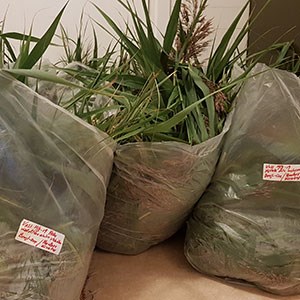Facts:
The project is financed by Formas and runs 2022 - 2025.

This project investigates whether reed silage can be used as roughage for horses. Reed is harvested in different plant maturations and analyzed with regard to energy value and nutrient content.
Harvesting reeds as fodder is not a new phenomenon, it is something that has been done for hundreds of years, but the interest in reeds as fodder has been renewed in recent years. Harvesting reeds from different types of lakes and watercourses can help to return plant nutrients to land that has ended up in the water via leakage from the soils. It can thus help reduce the effects of eutrophication of lakes and seas.
This project investigates whether reed silage can be used as roughage for horses (and cattle). Reeds will be harvested in different plant maturations and analyzed with regard to their energy value and nutrient content. The reed samples are also examined with in vitro methods to increase knowledge about the digestibility of reeds harvested in different stages. Furthermore, feeding experiments with both horses and cattle will be performed where both voluntary consumption and digestibility are examined. Effects of harvesting reeds on biodiversity and ecology are also included in the project.
The project starts in 2022 and ends 2025. It is financed by Formas and includes a doctoral student (William Ashworth). The project is implemented together with Örjan Östman (main supervisor) and Charlotte Berkström (assistans supervisor), Department of Aquatic Resources, SLU Aqua.
More information about HUV´s parts in the project: Cecilia.Muller@slu.se (assistant supervisor horse), Bengt-Ove.Rustas@slu.se (assistant supervisor cattle).
William Ashworth, william.ashworth@slu.se
The project is financed by Formas and runs 2022 - 2025.
Malin Connysson
Lecturer at the Department of Anatomy, Physiology and Biochemistry, research manager at Wången
malin.connysson@slu.se, +46 (0)640 174 31